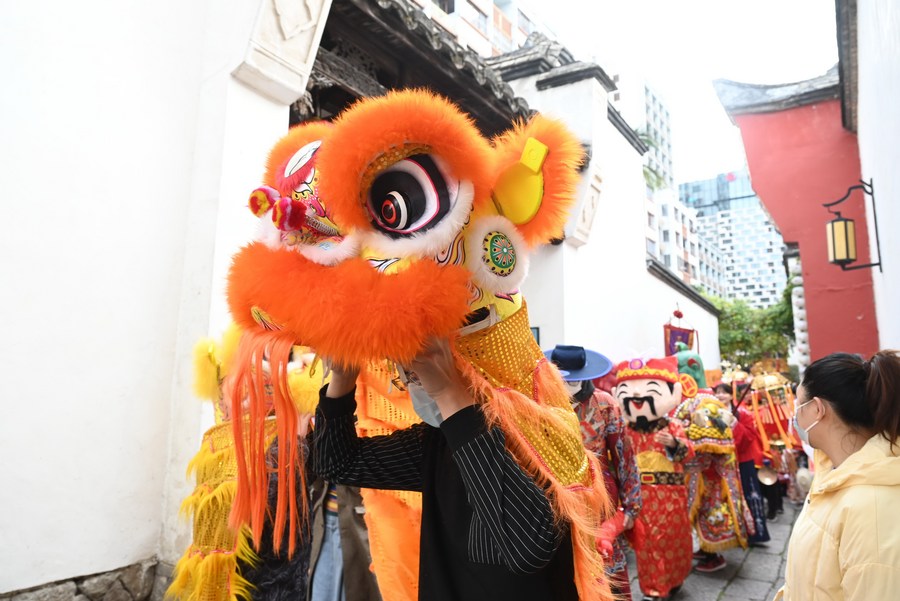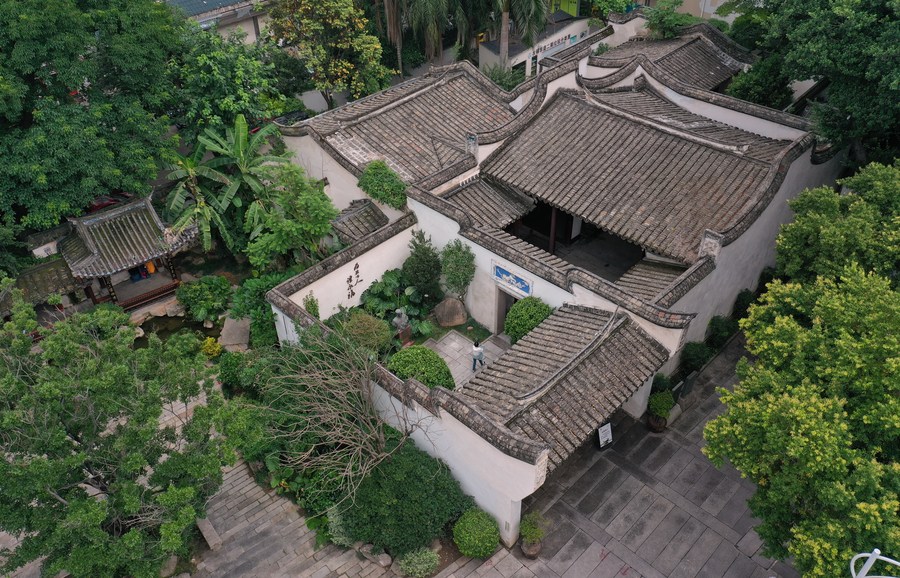Fuzhou turns ancient alleys into vibrant cultural hotspot

People take part in a parade welcoming the God of Wealth at Sanfangqixiang (Three Lanes and Seven Alleys), an ancient block in downtown Fuzhou, southeast China's Fujian Province, Jan. 26, 2023. (Xinhua/Lin Shanchuan)
FUZHOU, June 18 (Xinhua) -- Ask a young local in Fuzhou, the capital of southeast China's Fujian Province, about fancy new spots for dining and sightseeing, and they will likely point you to one of the three old neighborhoods: Yantaishan, Shangxiahang, or Sanfangqixiang.
Then ask Fuzhou old-timers -- they will recall how these centuries-old alleys were once a warren of firetraps, easily flooded in typhoon seasons and shunned by new businesses or home buyers.
The rebirth of these run-down areas as new attractions for nostalgic locals and tourists is a result of a new renovation strategy, which over the past decade, helped modernize the city's traditional alleys while preserving their original looks.
Zou Yuansheng is among the many young businesspeople who run a shop in Yantaishan, a historical neighborhood boasting a cluster of European-style old structures and a panoply of new businesses, including bars, cafes, and creative workshops.
His cafe, "Light and Dust Coffee," nestles in an old wooden house. It is filled with elements of Old Fuzhou, from slogans spelled in the Fuzhou dialect to posters of local deities drinking coffee.
After living overseas for years, Zou decided to start a business of Chinese-style coffee and was inspired by Yantaishan's unique ambiance of modernized traditions.
"I hope that our guests will get to know more about the city while drinking coffee," said Zou, who scatters the cafe with "The Foochowka," a magazine on Fuzhou traditions.
Yantaishan used to house many consulates, churches, and banks built after the city opened to foreign trade in the late 19th century. The neighborhood, however, became a run-down area in the new century after many historical buildings were reclaimed for residential use.
In 2018, the city launched a project to revamp it. Many old structures were renovated without changing their original appearances, while their interiors became available for commercial and tourist use.
The area is now popular among students and backpackers for its nostalgic ambiance and stylish shops. It receives an average of 30,000 visits daily and is packed on weekends and holidays.
With a history of 2,200 years, Fuzhou is home to many traditional alleys and ancient buildings. In recent years, the city has repaired more than 1,100 structures of historical significance and restored 261 old streets amid drives to rejuvenate the traditional neighborhoods.
The most famous ancient block rising from such renovation programs is Sanfangqixiang (Three Lanes and Seven Alleys), situated in the heart of Fuzhou. It is most famous for its green slate walkways and ancestral houses of historical personages, dubbed a "museum of the architecture of the Ming and Qing dynasties (1368-1911)."

This aerial photo taken on June 14, 2023 shows a view of the former residence of Lin Juemin, a renowned revolutionary hero, in Sanfangqixiang (Three Lanes and Seven Alleys) in Fuzhou, southeast China's Fujian Province. (Xinhua/Lin Shanchuan)
Nearly 200 historic structures in the area have been repaired since the 2000s. With restoring the original looks in mind, local authorities also explored solutions to keep the cultural buildings in a working state.
One key initiative is to open such buildings as themed museums, art workshops, and demonstration centers of local folk crafts. The main Nanhou Street of the block also invited time-honored local stores, including eateries of fish balls and meat floss, to settle in or open outlets.
The efforts have paid off. Sanfangqixiang has become a popular tourist destination in Fuzhou, receiving more than 10 million annual visits since 2015.
The traditional block of Shangxiahang, a 20-minute drive from Sanfangqixiang, has undergone a renovation project since 2014 and is now brimming with new cultural establishments.

People drink tea at a tea house in the Shangxiahang traditional block in Fuzhou, southeast China's Fujian Province, Feb. 26, 2023. (Xinhua/Lin Shanchuan)
A century-old former ancestral temple in the block is now a teahouse that entertains diners with talk shows and operas performed in the Fuzhou dialect.
Lin Feng, who runs the teahouse, aims to turn the ancient building into a place for reviving traditional arts. Both classic and new scripts of the local Min opera are regularly staged in front of a packed audience and live broadcast on the short-video platform Douyin.
"It is encouraging to see many young faces in the audience. They discussed with the elderly artists, and some even started to learn the art," Lin said.
Photos
Related Stories
- A glimpse of ancient buildings in Fuzhou, SE China's Fujian
- Seafood & Fisheries Expo opens in SE China's Fuzhou
- "Two Countries, Twin Parks" project set during Seafood &Fisheries Expo in Fuzhou
- Direct flights between Taiwan, Fuzhou resume
- Tea culture event held to celebrate International Tea Day in Fuzhou, SE China
Copyright © 2023 People's Daily Online. All Rights Reserved.









